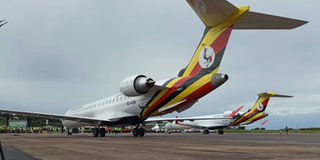African airlines register growing passenger traffic

Growing. Uganda Airlines arrives at a time when passenger traffic among Africa airlines is growing. FILE PHOTO
What you need to know:
Recorded growth. According to the 2018 International Air Transport Association (IATA) report, African airlines carried a total of 92 million passengers, recording a combined 5.5 per cent growth in the period.
African airlines continue to build capacity improving passenger and fleet numbers.
According to details contained in the 2018 International Air Transport Association (IATA) report, African airlines carried 92 million passengers out of the global traffic of 4.4 billion passengers.
The numbers, which exclude passengers ferried into the region by non-resident carriers, represent a 5.5 per cent growth.
The Asia-Pacific region reported the most growth recording passenger traffic of 1.6 billion passengers or 37.1 per cent of the global traffic.
The region saw passenger traffic expand by 9.2 per cent, while Europe and North America recorded 26.2 per cent and 22.6 per cent respectively.
In absolute terms, Europe accounted for 1.1 billion passengers while North America had 989.4 million passengers.
“Airlines are connecting more people and places than ever before. The freedom to fly is more accessible than ever,” said Mr Alexandre de Juniac, the IATA chief executive, noting that the number of city pairs connected by direct flights reached 22,000, an increase of 1,300 new pairs and more than double the 10,250 pairs that were connected two decades ago.
Latin American and Middle East grew 5.7 and 4 per cent respectively, reflecting the continuing impact of low fuel prices on the Gulf economies.
The 4.4 billion passengers carried on scheduled services during the year represent a 6.9 per cent expansion over 2017, or an additional 284 million trips by air.
Airlines also operated more efficiently with nearly 82 per cent of available seats being filled while fuel efficiency improved by 12 per cent compared to 2010.
“We understand that sustainability is essential to our licence to spread aviation’s benefits. From 2020 we will cap net carbon emissions growth. And, by 2050, we will cut our net carbon footprint to half 2005 levels. This ambitious climate action goal needs government support. It is critical for sustainable aviation fuels, new technology and more efficient routes to deliver the greener future we are aiming for,” Mr Juniac said.
IATA said better connectivity and competition brought on by low-cost carriers had reduced the real cost of air travel by more than half to 78 US cents per revenue kilometre today, compared with 20 years ago.
“The development of the low-cost carrier (LCC) segment continues to outpace that of network carriers. Measured in available seat kilometres, LCC capacity grew by 13.4 per cent, almost doubling the overall industry growth rate of 6.9 percent,” IATA says. Overall, LCCs accounted for 21 per cent of global capacity in 2018, up from 11 per cent in 2004. The global share of LCCs in 2018 was 29 per cent but this was largely a result of the short-haul nature of their business model. LCC’s constitute 52 of IATA’s 290 member airlines.
most travelled
The United Kingdom were the most travelled nationality, accounting for 126.2 million passengers or 8.6 of the global total.
They were followed by the United States of America at 111.5 million, China 97 million, Germany 94.3 million and France 59.8 million.
However, growth in the cargo segment was, however slower, posting 3.4 per cent growth in 2018 compared to 9.7 per cent in 2017.
A 5.2 per cent increase in capacity saw the freight load factor fall to 49.3 per cent during the period and year under review.




